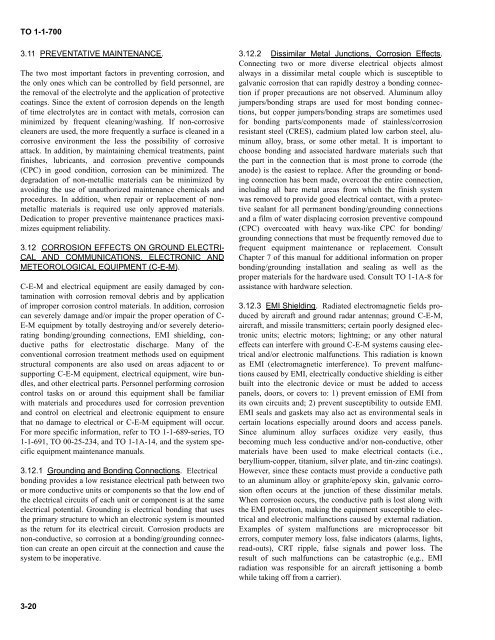TO 1-1-700 - Robins Air Force Base
TO 1-1-700 - Robins Air Force Base
TO 1-1-700 - Robins Air Force Base
Create successful ePaper yourself
Turn your PDF publications into a flip-book with our unique Google optimized e-Paper software.
<strong>TO</strong> 1-1-<strong>700</strong><br />
3.11 PREVENTATIVE MAINTENANCE.<br />
The two most important factors in preventing corrosion, and<br />
the only ones which can be controlled by field personnel, are<br />
the removal of the electrolyte and the application of protective<br />
coatings. Since the extent of corrosion depends on the length<br />
of time electrolytes are in contact with metals, corrosion can<br />
minimized by frequent cleaning/washing. If non-corrosive<br />
cleaners are used, the more frequently a surface is cleaned in a<br />
corrosive environment the less the possibility of corrosive<br />
attack. In addition, by maintaining chemical treatments, paint<br />
finishes, lubricants, and corrosion preventive compounds<br />
(CPC) in good condition, corrosion can be minimized. The<br />
degradation of non-metallic materials can be minimized by<br />
avoiding the use of unauthorized maintenance chemicals and<br />
procedures. In addition, when repair or replacement of nonmetallic<br />
materials is required use only approved materials.<br />
Dedication to proper preventive maintenance practices maximizes<br />
equipment reliability.<br />
3.12 CORROSION EFFECTS ON GROUND ELECTRI-<br />
CAL AND COMMUNICATIONS, ELECTRONIC AND<br />
METEOROLOGICAL EQUIPMENT (C-E-M).<br />
C-E-M and electrical equipment are easily damaged by contamination<br />
with corrosion removal debris and by application<br />
of improper corrosion control materials. In addition, corrosion<br />
can severely damage and/or impair the proper operation of C-<br />
E-M equipment by totally destroying and/or severely deteriorating<br />
bonding/grounding connections, EMI shielding, conductive<br />
paths for electrostatic discharge. Many of the<br />
conventional corrosion treatment methods used on equipment<br />
structural components are also used on areas adjacent to or<br />
supporting C-E-M equipment, electrical equipment, wire bundles,<br />
and other electrical parts. Personnel performing corrosion<br />
control tasks on or around this equipment shall be familiar<br />
with materials and procedures used for corrosion prevention<br />
and control on electrical and electronic equipment to ensure<br />
that no damage to electrical or C-E-M equipment will occur.<br />
For more specific information, refer to <strong>TO</strong> 1-1-689-series, <strong>TO</strong><br />
1-1-691, <strong>TO</strong> 00-25-234, and <strong>TO</strong> 1-1A-14, and the system specific<br />
equipment maintenance manuals.<br />
3.12.1 Grounding and Bonding Connections. Electrical<br />
bonding provides a low resistance electrical path between two<br />
or more conductive units or components so that the low end of<br />
the electrical circuits of each unit or component is at the same<br />
electrical potential. Grounding is electrical bonding that uses<br />
the primary structure to which an electronic system is mounted<br />
as the return for its electrical circuit. Corrosion products are<br />
non-conductive, so corrosion at a bonding/grounding connection<br />
can create an open circuit at the connection and cause the<br />
system to be inoperative.<br />
3.12.2 Dissimilar Metal Junctions, Corrosion Effects.<br />
Connecting two or more diverse electrical objects almost<br />
always in a dissimilar metal couple which is susceptible to<br />
galvanic corrosion that can rapidly destroy a bonding connection<br />
if proper precautions are not observed. Aluminum alloy<br />
jumpers/bonding straps are used for most bonding connections,<br />
but copper jumpers/bonding straps are sometimes used<br />
for bonding parts/components made of stainless/corrosion<br />
resistant steel (CRES), cadmium plated low carbon steel, aluminum<br />
alloy, brass, or some other metal. It is important to<br />
choose bonding and associated hardware materials such that<br />
the part in the connection that is most prone to corrode (the<br />
anode) is the easiest to replace. After the grounding or bonding<br />
connection has been made, overcoat the entire connection,<br />
including all bare metal areas from which the finish system<br />
was removed to provide good electrical contact, with a protective<br />
sealant for all permanent bonding/grounding connections<br />
and a film of water displacing corrosion preventive compound<br />
(CPC) overcoated with heavy wax-like CPC for bonding/<br />
grounding connections that must be frequently removed due to<br />
frequent equipment maintenance or replacement. Consult<br />
Chapter 7 of this manual for additional information on proper<br />
bonding/grounding installation and sealing as well as the<br />
proper materials for the hardware used. Consult <strong>TO</strong> 1-1A-8 for<br />
assistance with hardware selection.<br />
3.12.3 EMI Shielding. Radiated electromagnetic fields produced<br />
by aircraft and ground radar antennas; ground C-E-M,<br />
aircraft, and missile transmitters; certain poorly designed electronic<br />
units; electric motors; lightning; or any other natural<br />
effects can interfere with ground C-E-M systems causing electrical<br />
and/or electronic malfunctions. This radiation is known<br />
as EMI (electromagnetic interference). To prevent malfunctions<br />
caused by EMI, electrically conductive shielding is either<br />
built into the electronic device or must be added to access<br />
panels, doors, or covers to: 1) prevent emission of EMI from<br />
its own circuits and; 2) prevent susceptibility to outside EMI.<br />
EMI seals and gaskets may also act as environmental seals in<br />
certain locations especially around doors and access panels.<br />
Since aluminum alloy surfaces oxidize very easily, thus<br />
becoming much less conductive and/or non-conductive, other<br />
materials have been used to make electrical contacts (i.e.,<br />
beryllium-copper, titanium, silver plate, and tin-zinc coatings).<br />
However, since these contacts must provide a conductive path<br />
to an aluminum alloy or graphite/epoxy skin, galvanic corrosion<br />
often occurs at the junction of these dissimilar metals.<br />
When corrosion occurs, the conductive path is lost along with<br />
the EMI protection, making the equipment susceptible to electrical<br />
and electronic malfunctions caused by external radiation.<br />
Examples of system malfunctions are microprocessor bit<br />
errors, computer memory loss, false indicators (alarms, lights,<br />
read-outs), CRT ripple, false signals and power loss. The<br />
result of such malfunctions can be catastrophic (e.g., EMI<br />
radiation was responsible for an aircraft jettisoning a bomb<br />
while taking off from a carrier).<br />
3-20
















